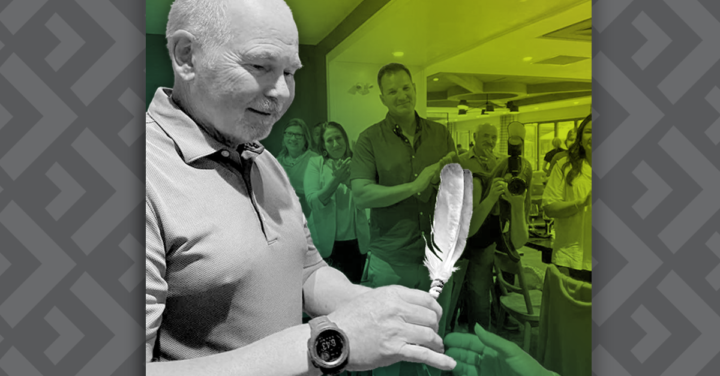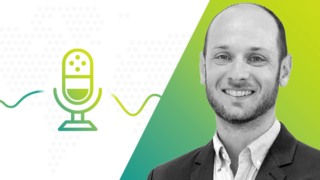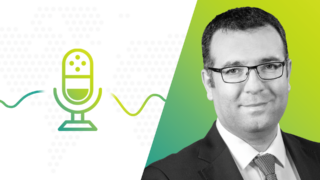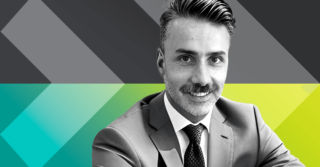
Tony Williams, FCIA, is a retired actuarial consultant with more than 40 years of pension, investment and benefits industry experience. Throughout his career, and even into retirement, Tony has provided many meaningful contributions to the Indigenous community. He was recognized in 2022 with an Eagle Feather, a very high honour for non-Indigenous people.
Before we talk about your endeavours in the Indigenous community, can you give us a brief overview of your career as an actuary?
I graduated with an Honours degree in actuarial mathematics from the University of Manitoba in 1977 and started my first job at Monarch Life in Winnipeg. Three years later, I began consulting and took a job as an actuarial student with a Winnipeg-based actuarial consulting firm.
After a few years, I moved to Calgary to take a job with an international consulting firm, Johnson and Higgins Willis Faber (J&HWF). At J&HWF, I primarily practiced pension and investment consulting. I also completed my actuarial exams around this time and became both an FCIA and an FSA.
From there, I took many different positions across the country – primarily focusing on pensions and investments – at several institutions, including Towers Perrin, Buck Consultants, and finally, Watson Wyatt.
In 2008, Watson Wyatt decided to exit the multiemployer plan business. A large part of my client base was tied up in this decision and so I organized a buy-out, forming a new company – PBI Actuarial Consultants. I was president of PBI for the remainder of my career, retiring in 2016.
I tried to get involved in other areas throughout my career, and I volunteered for the CIA and many other organizations. I was a frequent speaker at conferences on pension and investment issues. I was a member of the Committee on Investment Practice and served as chair for several terms. I additionally served on the Actuarial Standards Board for five years.
You’ve been working with a number of groups that have been involved with Indigenous issues. Can you tell us about these organizations, what they are working to accomplish and how you have contributed?
Throughout my career I’ve had many opportunities to work for some very prominent Indigenous clients – there are quite a few, in fact! One organization I’ve had the pleasure of working with for many years is the Nisga’a Lisims Government in Northern BC. I assisted them with their treaty settlement money until my retirement to help them gain good, prudent control of it.
Another organization is the Vuntut Gwitchin in Yukon, which I assisted with their Elder payment program around 2008. I demonstrated to them that their monthly payments to Elders were essentially a pension plan and that their liabilities were growing. My report was presented at the Vuntut Gwitchin General Assembly near Old Crow, Yukon, and was simultaneously translated into Gwich’in.
In 1993, I became involved in the investment of the Gwich’in treaty money in Fort McPherson of the Northwest Territories. I was eventually retained as an investment expert witness in the Albertan lawsuit for the Samson Cree Nation versus the Queen. This work for the Samson Cree went on for a number of years, during which I provided extensive testimony in court. It also eventually led to my assisting the Samson Cree with the establishment of a $350 million Kisoniyaminaw Heritage Trust Fund.
I retired in June 2016 due to health issues, but I continued to contribute to the community by joining the volunteer board of the Verna J. Kirkness Education Foundation. The Foundation aims to increase the number of First Nations, Métis and Inuit students earning degrees in science, engineering and medicine. About three years ago, I became chair of the board and continue to operate as the volunteer chair.
Also around 2016, I established two endowment funds by making donations to the University of Manitoba. These endowments benefit Indigenous students pursuing education in science at the university. I eventually became a member of the Faculty of Science Dean’s External Advisory Board. In this capacity, I made the seed donation so that the University of Manitoba could establish the Wawatay program, which is designed to improve the chances of Indigenous science students earning their degree.
Finally, in 2018, I became involved with the Worldwide Indigenous Science Network (WISN) of Lahaina Hawaii. I have been working as a volunteer and donor for WISN to establish an Indigenous science and peace studies program at the United Nations’ University for Peace in Costa Rica. I have found this work as a donor and volunteer for Indigenous science causes to be highly rewarding personally.
That’s quite an extensive resume! You’ve also been a member of the CIA’s Diversity, Equity and Inclusion Advisory Group. What have been some of the key priorities of this group?
I joined this advisory group of the CIA in the fall of 2022. The group has a broad mandate to review and make recommendations to improve the participation of students in underrepresented groups such as Indigenous Peoples, Black persons and other people of colour. My personal focus in this group is on Indigenous underrepresentation. Currently, there are very few Indigenous actuaries.
We do have a notable lack of Indigenous members in the actuarial profession. Can you share your thoughts on why that is and what we might be able to do to address that?
In my work with the Vuntut Gwitchin Elder payment program in 2004, I asked the client why they did not select an Indigenous actuary. The answer was that they couldn’t find any. From that point on, it became part of my mission to try to correct that underrepresentation however I could help.
More evidence of this issue arose a couple of years ago when the CIA conducted a diversity survey. The results showed that the CIA membership was less than 1% Indigenous. If representation was based on populations, then that percentage should have been 5-6%. I read this as an issue with CIA leadership and helped form a partnership between the Actuarial Foundation of Canada and the Verna J. Kirkness Education Foundation in order to help address this concern.
I am hopeful that the CIA will develop programs to encourage young Indigenous students to study math and for some of them to eventually pursue actuarial careers and the designation of FCIA.
You recently received a rather prestigious award from the Verna J. Kirkness Education Foundation. Can you tell us about that?
The Kirkness Foundation held a retreat meeting in Kananaskis in August 2022, which I attended as a board chair. Quite unexpectedly I was awarded an Eagle Feather by the Indigenous members of the Foundation at a board dinner. Receiving an Eagle Feather is the highest honour that an Indigenous group can bestow upon a non-Indigenous person.
I was very pleased that the Kirkness Foundation’s board of directors had been tracking the activities that I have been undertaking since 2015 to improve education opportunities for Indigenous students, especially as I see my work as consistent with the Truth and Reconciliation Commission’s 94 Calls to Action. I accepted this very high honour humbly and cherish the feather as a sign that my work has been recognized.
The CIA recently partnered with the Actuarial Students’ National Association to offer three scholarship awards to actuarial students, including the Indigenous Award, the Inclusive Culture Award and the Academic Achievement Award. The Indigenous Award was, unfortunately, not awarded this year due to limited applicants, but we are hopeful that it will be in the years to come.
The opinions expressed in this article reflect those of the interviewee and does not represent an official statement of the CIA.
The following comments were shared by readers:
Marilyn Buffalo: Dear Tony,
Thank you for your wonderful contribution to establishment of New Indigenous Initiatives for Inclusion of future Indigenous Youth in your lifetime chosen field. As a Grandmother and Great-grandmother this brings me great hope that future generations of youth will benefit greatly in following your footstep career building methods like Kirkness Foundation that will benefit our Indigenous Nations nationwide.
Secondly, on behalf of my Buffalo Family, and also as a Former Senior Policy Advisor to Samson Cree Nation, I thank you for your expert testimony in Buffalo v. The Queen, a landmark treaty rights case where I had the privilege of working with you and the litigation team and Elders. I believe we set a framework that others will follow. Yours in Truth and Reconciliation. Morning Sun Woman, Marilyn Buffalo, Treaty #6.
Verna Kirkness: Thank you for making this great article available for circulation. Tony has been a very special as president and chair of the Kirkness Education Foundation. This is obvious from the experience he has had in working with Indigenous groups that continue to regard him very highly. He is passionate about Indigenous challenges and is at the forefront of understanding our issues and providing the expert and kindly advice to assist us in moving forward. We are fortunate to have Tony who is, indeed, playing an important role to help the Indigenous people of Canada and beyond.
Stephen Taylor: Glad to read this. I am probably one of the few First Nations people who is an FCIA but have been retired for nearly 20 years. I received my designation in 1977. Hopefully there will be young Indigenous people who will become interested in the actuarial profession.






Dear Tony,
Thank you for your wonderful contribution to establishment of New Indigenous Initiatives for Inclusion of future Indigenous Youth in your lifetime chosen field. As a Grandmother and Great-grandmother this brings me great hope that future generations of youth will benefit greatly in following your footstep career building methods like Kirkness Foundation that will benefit our Indigenous Nations nationwide.
Secondly, on behalf of my Buffalo Family, and also as a Former Senior Policy Advisor to Samson Cree Nation, I thank you for your expert testimony in Buffalo v. The Queen, a landmark treaty rights case where I had the privilege of working with you and the litigation team and Elders. I believe we set a framework that others will follow. Yours in Truth and Reconciliation. Morning Sun Woman, Marilyn Buffalo, Treaty #6.
Thank you for making this great article available for circulation. Tony has been a very special as president and chair of the Kirkness Education Foundation. This is obvious from the experience he has had in working with Indigenous groups that continue to regard him very highly. He is passionate about Indigenous challenges and is at the forefront of understanding our issues and providing the expert and kindly advice to assist us in moving forward. We are fortunate to have Tony who is, indeed, playing an important role to help the Indigenous people of Canada and beyond.
Glad to read this. I am probably one of the few First Nations people who is an FCIA but have been retired for nearly 20 years. I received my designation in 1977. Hopefully there will be young Indigenous people who will become interested in the actuarial profession.